I strolled through Harvard University recently on what should have been a busy Friday morning. The solitude was striking, with once-lively routes deserted and nearly all libraries and classrooms shut, along with sports facilities, public halls and museums. Hardly any buildings, including dormitories, showed signs of life. Even scientific laboratories had only skeletal crews. It's a great time to find a parking space.
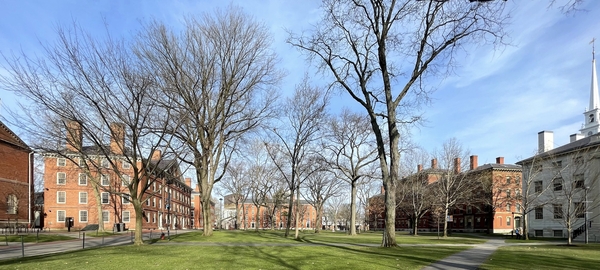 An almost empty Harvard Yard at noon on Friday. Can you find the humans? |
Buildings are locked to the public. A university ID is required to enter. This reminded me of the time in 1984 when, on a lark, I tried to enter the high-rise that houses Moscow State University, only to be carded by Soviet apparatchiks and refused entry.
Nothing in my nearly seven decades' knowledge of Harvard (which started with preschool in 1952) prepared me for this lonely ramble. It prompted me to ponder the four existential challenges facing universities:
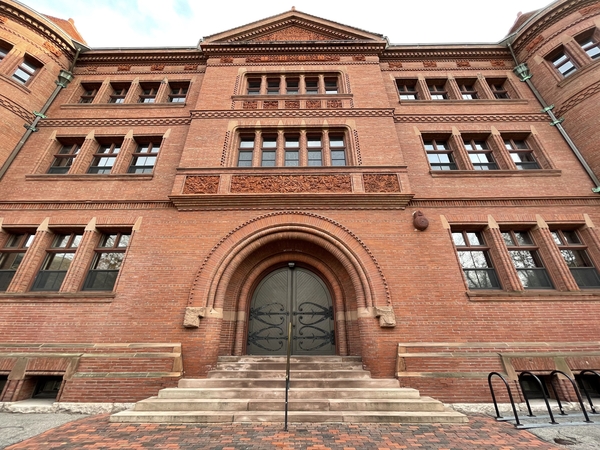 A tightly sealed Sever Hall, its classrooms inaccessible. |
• The internet. The Western university dates to the founding of the University of Bologna in 1088. It remains an essentially medieval institution, with scholars educating students clustered in their immediate presence. Although "massive open online courses," cutely known as MOOCs, haven't generally taken off, a massive reliance on Zoom instruction has finally proved the internet's potential to disrupt the dominant, archaic model.
• Extreme leftism. The academy's liberalism dates back a century (to the aftermath of World War I) and its radicalism a half-century (to the 1960s). The passage of time finds the faculty ever more wildly radical in its teachings, indulging in increasingly preposterous flights of absurdity. This zealotry upsets not only conservatives; prospective students also realize the limited utility of a degree in Lesbian, Gay, Bisexual, and Transgender studies.
• Exorbitant prices. Columbia University costs $64,380 a year in tuition and fees (plus housing). Higher education has lost its role as a "lubricant" of upward social mobility, explains marketing specialist Scott Galloway, instead turning into more of a "caste system" primarily serving the privileged. University staff are "no longer public servants, but luxury goods who are drunk on exclusivity and brag about turning away 80, then 85, then 90% of applicants."
• Covid-19. The sudden focus on personal physical safety disrupted previously stable models of student recruitment, teaching, tuition, fundraising, and employment. In-person attendance will return, but long-smug institutions are scampering to find new procedures.
Harvard might seem immune to these problems, with its $50 billion in assets, the country's largest, and a college acceptance rate of 4.6%, among the country's lowest. But even Harvard—which, Mr. Galloway notes, has become a slightly absurd "$50,000 streaming platform"—faces a reckoning in the Zoom era. How might that reckoning look? Here's a prediction:
MOOCs will finally fulfill their potential. Laurie Santos, a Yale psychology professor, already attracts nearly a quarter of the Yale student body to her lectures on "The Science of Well Being," making it the most popular course in Yale's 320-year history. More important, the course that started on Saturday boasts a non-Yale audience of 3.4 million participants.
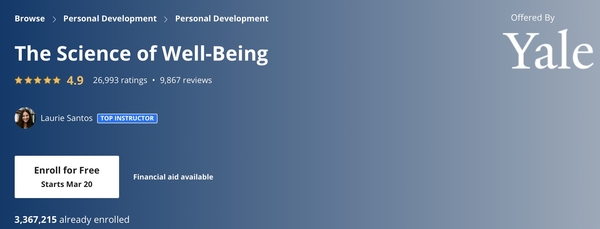 One current Yale University course has nearly 3.4 million participants. |
The appearance of such huge courses at a moment when lesser institutions are failing suggests that a few star universities will flourish while the rest starve and die. Patterns in college applications imply this trend is already under way. Imagine a reduction from some 5,300 U.S. colleges and universities to 50, each with its renowned outlook (including some conservative ones), specialties and strengths. Thousands of existing campuses will become shared satellite facilities for those 50, complete with dormitories and sports facilities.
Courses like Ms. Santos's will require legions of teaching assistants and graders who meet in person with students, giving education the personal touch and community grounding essential to its mission. The California State University system, with 23 campuses, foreshadows this geographic dispersal, as does the distinction between full-time and adjunct faculty. In-person advanced seminars with star professors will continue as ever, training the next generation of scholars.
Tuition will come crashing down as economies of scale come into play, truly opening education to all and ending the student-loan crisis.
The taxi system was unreliable, expensive and unpleasant, so along came Uber and overturned it. Higher education, even more antiquated than taxis, is due for a comparable shock—and the sooner, the better.
Mr. Pipes founded Campus Watch and is president of the Middle East Forum.
Mar. 22, 2021 addenda: Addressing reader concerns:
1. Can the star-and-satellite system work for the sciences where laboratories are required? Yes, satellite campuses can provide those facilities.
2. Will not a reduction from 5,300 decision-making institution to 50 entail a catastrophic reduction in diversity? Not really, for those thousands offer precious little diversity at present and the few remaining universities might have more incentive to differentiate themselves.
Readers also responded with helpful information to confirm my arguments above.
1. Already in 1975, William K.S. Wang anticipated these changes in his article, "The Unbundling of Higher Education":
For many years, universities organized along traditional lines have almost totally dominated higher education. Until recently the universities' power could be justified because no other means of purveying higher education was technically feasible. Improvements in communications technology, however, have made possible the development of degree-granting programs, often called "open universities," that are no longer tied to the inflexible curriculum or expensive facilities and programs of conventional universities. It is the thesis of this Article that the current structure of the university system has retarded this development and that an antitrust attack on the monopolistic practices of private universities is feasible and should be successful.
2. The Online Master of Science in Computer Science (OMSCS) degree program at Georgia Institute of Technology's College of Computing (CoC), developed in cooperation with the online learning platform Udacity, is a MOOC that launched in January 2014. Zvi Galil, the CoC dean, explains:
While the selectivity of the on-campus Master in Computer Science program (MSCS) is slightly higher than 10%, 70.7% of the more than 26,000 OMSCS applicants were admitted. Added to the novel admissions policy, I insisted on keeping OMSCS tuition affordable—less than $7,000 for the full degree, payable by course, rather than $40,000 for a public on-campus program, or $70,000 or more in a private university. ...
the data strongly suggests there is nothing inferior about the online course experience: students regularly rate their online courses as better than on-campus courses they have taken, and they regularly match or exceed the performance of their on-campus counterparts. ...
We learned that high-quality low-cost online degrees are realizable and viable—OMSCS has been financially self-maintaining since its third year, ... and thus far has produced cumulative net income to Georgia Tech of $13 million.
3. Arizona State University has joined forces with edX to create the Global Freshman Academy, which it describes as "offering a unique, cost-effective way to break down the barriers to a quality education. GFA provides students the opportunity to complete their entire university freshman year coursework, risk free, and pay for the credit earned after passing the course. Courses are open to everyone with no application or transcripts required." GFA "offers individuals of all backgrounds the opportunity to take the same courses, from the same faculty as on-campus ASU students."
A February 2019 article in the Chronicle of Higher Education, "The Rise of the Mega-University," looks at some universities with huge enrollments, including Southern New Hampshire, Liberty, Grand Canyon, and Western Governors. Their success suggests it may not be the big-name universities that thrive in the future, but those that move rapidly to fill student needs.
4. The Mayo and Cleveland Clinics, which open satellite institutions in many locations, offer a possible model for universities.
Apr. 6, 2021 update: David Kirp of UC-Berkeley argues that the most prestigious American universities should clone themselves - a step toward the model I proposed above:
A top private university like Princeton or Yale (or perhaps a renowned college like Amherst or Swarthmore) should open a new campus.
The institution would not have to lower its standards, because the best and brightest would queue for admission. Professors with glittering résumés would jump at the opportunity to teach there — indeed, for the adventurous Yale-caliber academic, the opportunity to be present at the creation could be a powerful draw. Cities would perform handstands to land such a school.
Harvard-San Diego, Yale-Houston — this idea is not simply off the table in academe. It is not even within the realm of these universities' imagination. But why should it boggle the mind? If Yale can open a campus in Singapore, why can't it start one in Houston?
May 7, 2021 update: I omitted a fifth existential challenge to American universities: "A Historic Decline in U.S. Births Signals More Enrollment Troubles." An excerpt: "with a smaller pool of college-age students ... competition for them will only stiffen. Wealthy, selective colleges won't see a drop in demand, ... leaving questions about how smaller, regional institutions will fare." Oct. 26, 2021 update: Further confirmation, from U.S. News & World Report: "College Enrollment On Track for Largest Two-Year Drop on Record. Higher education enrollment rates dropped for the second straight year, defying predictions of a post-lockdown bounceback and hitting a record low for a two-year span." Jan. 13, 2022 update: Total college enrollment in the fall of 2021 dropped 2.7 percent from a year earlier, a decline of 476,100 students.
June 3, 2021 update: On the emergence of another "mega-university," the University of Arizona, see "A New Mega-University Expects to Earn Big Money Immediately. Are Its Projections Too Ambitious?" Aug. 1, 2022 update: Today's news suggests those projections were too ambitious: "Two Years After Promising a 'Transformational' Partnership, the U. of Arizona and Zovio Part Ways."
June 16, 2021 update: From the Chronicle of Higher Education: "Since 2016, colleges have failed for many reasons: changing demographics, fewer students with a religious background (impacting the many small colleges with a religious affiliation), a drop in interest in single-sex institutions, and changing student preferences for urban over rural environments."
Sep. 1, 2023 update: The same process is underway in another advanced country: "Australia's Great Divide: Rich Universities Grow as Others Falter."
Apr. 10, 2024 update: An article on the closure of Goddard College mentions in passing other institutions of higher education that have shut their doors in 2024:
Goddard is now the fourth college to announce a closure in less than a month, following Oak Point University in Illinois, Birmingham Southern College in Alabama and Fontbonne University in Missouri, all of which cited enrollment and financial issues.
Notre Dame College in Ohio announced its looming closure in late February. And in January, the Pennsylvania Academy of the Fine Arts said it would end its degree offerings.
Other institutions have publicly acknowledged they are teetering on the brink of closure, including Northland College in Wisconsin—which has attempted to fundraise its way out of financial distress with limited success—and Eastern Gateway Community College, which has paused registration and is expected to close unless it receives an influx of funding by the end of May. Saint Augustine's University, a historically Black university in North Carolina, is also facing existential challenges as it contends with financial issues and the loss of accreditation. And Union Institute & University in Ohio is stuck in limbo, under state and federal scrutiny for its failure to pay employees and alleged misuse of federal student aid dollars. Union Institute has not offered classes in recent months but has made no announcement about a potential closure.
June 3, 2024 update: Here's a possible sixth existential challenge, as described in an article titled "The Lure of Work: In Iowa, enrollments are falling as businesses recruit high-school grads. Can colleges come up with a better pitch?"
July 30, 2024 update: Mills College, a small institution for women founded in California in 1852, was about to fold in 2021 when Northeastern University, a large research university in Boston took it over. Avoiding the cumbersome formal name, Mills College at Northeastern University, most call it the Oakland campus. In covering this merger two years later, the Chronicle of Higher Education ponders how, "As contraction in the higher-education sector continues, more colleges will be forced to reckon with what the loss of their identity might mean."
Aug. 12, 2024 update: I imagined just 50 universities; Audrey Williams June
published an article today in the Chronicle of Higher Education imagining "What Would Higher Ed Look Like Distilled Into 100 Institutions?" (The answer is less interesting than the question.)
Aug. 21, 2024 update: In 1966, 2.49 million Japanese turned 18 years old in 1966, about 1.1 million did so in 2023, and a mere 820,000 are projected to do so in 2040. This two-thirds decline has ominous implications for Japanese universities; the Japan Association of National Universities has issued a draft interim report that, in a newspaper paraphrase, "has sparked discussions on the need for consolidation, downsizing, or potential closures."
Aug. 22, 2024 update: A report from the National Center for Education Statistics finds that the number of Title IV higher education institutions (those eligible to participate in federal financial aid programs) shrank by 99 institutions, or 1.7 percent, from 5,819 in the 2023–24 academic year compared to 5,918 in the 2022–23 academic year. Data from the U.S. Department of Education clarifies that 161 institutions lost Title IV status while 62 institutions opened, bringing the net decline to 99. A further breakdown finds that 73 institutions closed, 17 merged, and 71 otherwise lost their Title IV eligibility.
Clare McCann, director of higher education at Arnold Ventures, a philanthropic group, commented that "We're likely to continue to see closures in the coming years, especially as financially struggling colleges cope with falling enrollment and the expiration of pandemic-connected relief funds."
Aug. 28, 2024 update: Daniel Greenstein explains how, as chancellor of the Pennsylvania State System of Higher Education since 2018, he merged 6 of the system's 14 four-year public universities into 2, Pennsylvania Western University and Commonwealth University of Pennsylvania, in an attempt to save them from fiscal ruin.
Oct. 9, 2024 update: "See how we are expanding access to students across the U.S." urges Arizona State University in a long and glossy brochure announcing its intention to survive the coming onslaught as "The New American University." (It even includes a picture of a dinosaur.)
Feb. 28, 2025 update: A working paper by Robert Kelchan, Dubravka Ritter, and Doug Webber examining factors associated with college closures finds that
Enrollment growth in recent years has been concentrated at a small number of flagship public and wealthy private universities, while regionally focused institutions — engines of social mobility — have generally struggled. Tuition prices have increased more slowly than the rate of inflation for much of the last decade, and rising tuition-discount rates have reduced revenue for many colleges. On the other side of the ledger, operating costs have risen quickly since the pandemic and typically outpace gains in revenue.
Apr. 15, 2025 update: Richard K. Vedder, Distinguished Professor of Economics Emeritus at Ohio University, has published Let Colleges Fail: The Power of Creative Destruction in Higher Education (Independent Institute). From the publisher:
Why do we subsidize universities through taxpayer-provided grants and private donor gifts when the institutions are so obviously failing America's youth? How can we justify this special status, while businesses offering far more useful goods and services are punished by confiscatory taxes—for simply turning a well-deserved profit? ...
Vedder reminds Americans of the concept of "creative destruction" (famously introduced by economist Joseph Schumpeter)—the idea that, because markets threaten to reallocate resources from unproductive to productive uses by "creatively destroying" failing businesses, markets actually help failing businesses adapt to the market's ever-changing needs and realities. It's sink or swim. ...
if universities want to survive, says Vedder, they must learn to swim, too. But because we have cushioned them from the demands, necessities, and realities of public life, American colleges are weak, woke, and unforgivably obtuse. Their eye-stretching price tag just adds insult to injury.
Apr. 29, 2025 update: In an interview with Susan H. Greenberg, "A Little Failure Goes a Long Way," Vedder explains his basic ideas. One excerpt:
I want colleges to realize that they need to step up their act and maybe change a little bit more than they have, be more aggressive in reformulating themselves—partly on the cost side, to become less expensive, but also to become focused on job one: teaching and research. It's the act of disseminating and discovering knowledge, and that's what we're about. We do a lot of other things that are distractions—like March Madness. It's great entertainment, but it's a ball-throwing contest. If you go to Oxford or Cambridge, you don't see basketball being played at a professional level, sponsored by the university.
Apr. 30, 2025 update: Limestone University, founded in 1845, has announced it will shut down at the end of the semester. My reaction is: however historic these institutions, the psychological impact will only come when closures take place at colleges and universities one has heard of.
Oct. 22, 2025 update: The webpage, "Our Global Campuses" of Northeastern University reveals twelve locations other than the historic Boston one: Arlington VA, Burlington MA, Charlotte, London, Miami, Nahant MA, Oakland, Portland ME, Seattle, Silicon Valley, Toronto, Vancouver. (A thirteenth, in Manhattan, is in the works.) Northeastern, with a $2 billion endowment, is not even one of the heavyweights.
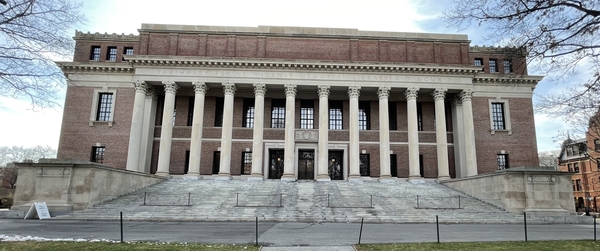 More pictures from Harvard: Widener Library is quiet. |
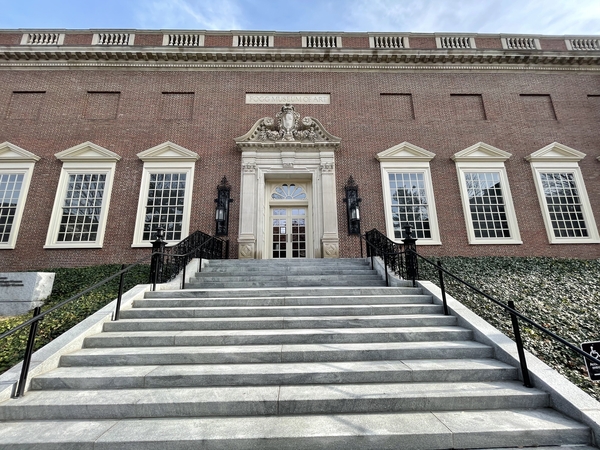 The Fogg Museum of Art is closed. |
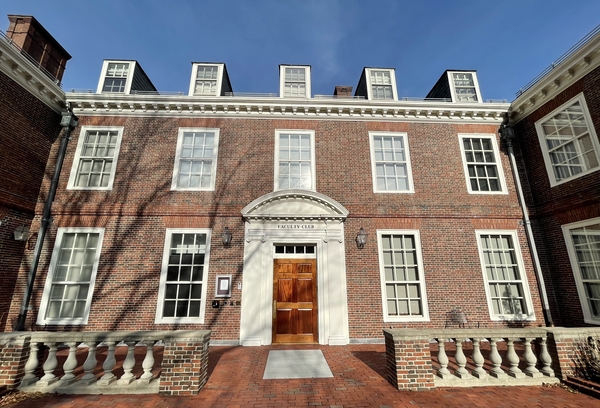 No faculty at the Faculty Club. |
